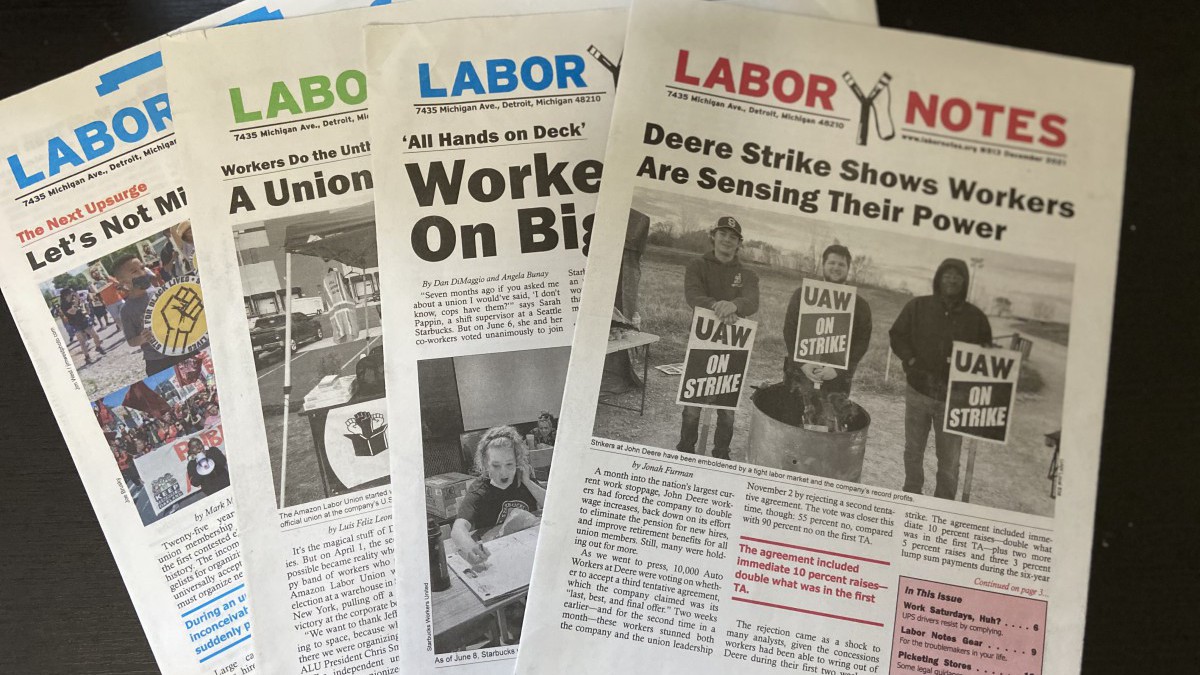We are living in a historical moment in labour history. At a time when corporations have more power, profit, and political influence than ever before, thousands of workers are leading inspiring organizing campaigns and taking on billionaire bosses. Reporting from the front lines of these struggles are the labour-focused publications RankandFile.ca and Labor Notes.
RankandFile.ca has been covering Canadian labour news and analysis from the grassroots since 2012. The publication has built a national rank-and-file network that covers the labour movement from B.C. to Newfoundland and Labrador, and it has built its name by reporting on the strategies, wins, and losses of the labour movement from the perspective of workers themselves.
Labor Notes, founded in 1979, is a labour media and organizing project connecting workers’ struggles in the U.S. The project is known for its long-standing magazine and annual labour conference and has a reputation for being a troublemaker in the labour movement, earning this title through critique of union strategy, encouraging workers to organize outside of formal union positions, and strong emphasis on rank-and-file activism. Now over four decades old, Labor Notes’ articles, conferences, books, webinars, and workshops are an essential source of information and resources for workers, unions, and labour activists. Whether you’re brand new to the labour movement or a seasoned organizer looking for inspiration, practical advice, or to deepen your understanding of unions, these articles from RankandFile.ca and Labor Notes are essential reading for all workers organizing to win.
“Organizing Despite the Churn,” Labor Notes (2023)
In my work as a union organizer, workers have often told me that “we can’t have a union here, turnover is too high.” Union certification drives are built around a complex legal framework with demanding timelines for filing union cards and holding elections. In high turnover workplaces, it can be challenging to organize drives and internal union campaigns before workers move on. This Labor Notes article by Jenny Brown focuses on organizing workplaces where churn is built in, like universities employing students who leave when they graduate and companies with terrible working conditions that force workers out, like behemoth Amazon.
Some strategies for organizing high turnover workplaces are keeping contracts short, bargaining guaranteed union orientation for new hires, and developing a co-worker culture. In my experience, creating a culture of worker solidarity is one of the most essential and easily overlooked parts of an organizing campaign. Brown focuses on union drives, but the importance of creating and maintaining a co-worker culture is a good reminder for all workers.
“The Viral Crash,” RankandFile.ca (2020)
In this article, David Bush presents a comprehensive and critical analysis of the ongoing COVID-19 pandemic’s impact on the global economy. He highlights the impact of the pandemic on industries, stock markets, and workers. Connecting the pandemic’s economic fallout to the systemic flaws of the capitalist system, he traces workers’ financial precarity back to the 2008 financial crash and the neoliberal policies that exacerbate inequalities and rely on overproduction.
In true RankandFile.ca fashion, Bush’s piece makes complex concepts like stock devaluations and corporate debt accessible and explains how they affects us. He concludes that it’s up to workers and their unions to organize for a future that puts people over profits.
“Migrant farm workers achieve an important victory at Floralia,” RankandFile.ca (2017)
This article by Daniel Tseghay discusses Canada’s Seasonal Agricultural Worker Program and the migrant workers who fought against their bosses to win. It covers the working conditions that migrant labourers face and how the Mexican government conspired to blacklist workers who supported unionizing Floralia Plant Growers Ltd. Tseghay explains how the employer used workers at one of their other companies as scabs, circumventing the law and disregarding the collective agreement outlining that workers are to be recalled based on seniority.
Organizing migrant agricultural workers is a huge challenge, but this piece highlights the successful efforts of the United Food and Commercial Workers Local 1518 to do so. It’s especially difficult for agricultural workers to unionize, as they face fears of employer retaliation or deportation and have limited access to legal support, and union organizers are often not allowed on farmers’ property. Legal institutions are rarely on the side of workers, but in this case, the B.C. Labour Relations Board mandated the employer to reinstate workers and extend their collective agreement, and it limited the employer’s ability to use non-unionized workers from the employer’s other company. This victory belongs not only to the Local 1518 members involved, but all migrant workers and organizers fighting for better working and living conditions.
“Building a caucus to rebuild union power,” RankandFile.ca (2022)
Ben Sichel highlights how unions must prioritize empowering their members over labour-management committees and bureaucratic processes. Sichel analyzes the professionalization of unions and how unions became more formal, structured organizations with paid specialized staff. He tears down the employer myth that unions are meddling third parties that don’t have workers’ best interests at heart and provides examples of successful campaigns where workers understood that they are the union.
To change professional union culture, Sichel advises readers to organize in caucuses, “groups who come together independently of official union structures to strategize about moving the union in a more activist direction.” Sichel reminds readers that the Chicago Teachers Union and United Teachers Los Angeles – both of which have organized supermajority strikes leading to major bargaining wins in the past few years – began as caucuses. Members fed up with the reformism of their unions partnered with community groups to form the caucuses, shifted the unions conversations, and went on strike for community priorities like expanding green space at schools, limiting random searches of students, and supporting immigrant students and families.
“Concessions Didn’t Work Then and They Won’t Now,” Labor Notes (2020)
This article is written by the incomparable Jane Slaughter, whose decades of contributions to the labour movement as an organizer and a journalist have been critical to my development as a union educator. Slaughter is a former editor of Labor Notes and she literally wrote the book on beating concessions. Her book, Concessions and how to beat them, came out in 1983 and is sadly still relevant today.
In this article, she revisits the underlying causes of concessions, taking readers back in time to when the auto industry began demanding rollbacks from unions to protect jobs. Slaughter points out that some union leaders were more willing to concede to the bosses’ demands in the name of “labor-management cooperation.” But when unions agree to contracts with concessions, whether for wages or benefits, they lose credibility with workers. This article serves as a call to action for workers to reject concessions, not lose hope, and organize for the gains we’re entitled to.







